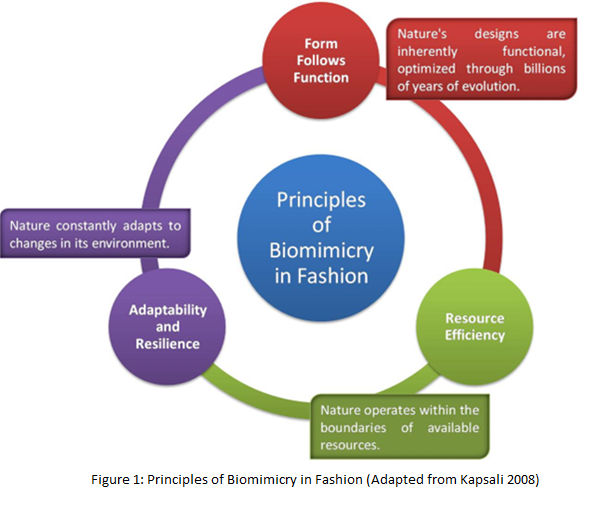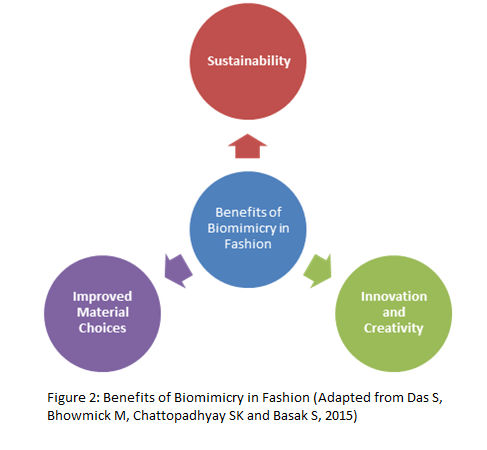Currently, several industries are looking for sustainable innovation. Biomimicry, over the last few years has become a very important and useful tool to handle such scenarios. The field of biomimicry draws inspiration from the mother nature for product and process design. The fashion industry has also embraced this concept to design apparel that are sustainable and environment friendly. The principles of biology, ecology and sustainable sciences are applied to develop new materials and processes that reflect the efficiency of nature. The adoption of biomimicry in the fashion industry can help in tackling the environmental issues caused by this sector.
The words, ‘fashion’ and ‘sustainable’, often do not go hand in hand. It is because fashion is fast changing, trendy and addictive, whereas sustainability is about slow consumption. However, biomimicry provides a solution to bridge this gap. The word ‘biomimicry’ is of Greek origin, meaning imitating life. It involves looking at nature for innovative and sustainable solutions. It aims to promote ecological balance, resource efficiency and creative design.
The fashion industry is one of the most polluting sectors with massive negative impacts on the environment. Huge volumes of water usage, waste generation and chemical discharges are just a few issues. However, by adoption of biomimicry in the product design and processes, the industry can shift to a more sustainable approach. Nature has evolved through millions of years and solutions derived from nature are much more efficient, resourceful and sustainable.
A number of fabrics like cotton, silk and wool require high volume of resources and are hazardous to the environment. Biomimicry inspires to look for alternate materials that have the properties of these fabrics, and yet are sustainable in nature. For example, the structure of spider silk has inspired scientists to create bioengineered silk. This alternative silk is strong and light weight and is more sustainable than the conventional silk production. Biomimetic methods have produced cotton like fibres from plant wastes. This reduces the excessive requirement of land and chemical usage in the process. Fashion designers can take inspiration from the broad spectrum of nature’s designs. According to the Biomimicry Institute located in Missoula, Montana, United States, designers will be able to create fashion that is both aesthetic and sustainable by just the observation of complex patterns, shapes and colours of the natural world.
Biomimicry in fashion involves emulating nature’s patterns, processes, and systems to create sustainable textiles, manufacturing techniques, and design aesthetics. 
Figure 1 shows the principles of biomimicry. To create sustainable designs inspired from nature it is important to be guided by these principles. By prioritising the functional aspect of any design, nature optimises the process. Similarly, with ample understanding of structures and patterns, designers can create apparel that can serve the functionality efficiently. Nature also limits its designs within the available resources. By imitating this concept of resource efficiency, the fashion sector can reduce consumption of energy, generate minimal waste and optimise the material requirement. And finally, nature adapts and evolves along with the environment. Garments can be made to adapt and respond to the changing climatic conditions like temperature and moisture.
It is evident that biomimicry offers enormous benefits if applied to the fashion industry. Figure 2 shows the broad categories of these benefits.

Biomimicry can provide alternate sustainable practices for the fashion industry. These practices can be less toxic to the environment. The mimicking of design strategies of nature can reduce carbon footprints, optimise resources and improve circularity. Secondly, nature is an amazing source of wide array of varied design inspirations. The concept of biomimicry urges the designers to think out of the box. And finally, nature provides an extensive range of materials that are organic and regenerative and thus can replace the hazardous impacts of the synthetic materials. This field encourages designers to explore and use bio-based materials. Bamboo fibre, seaweed, mushroom leather etc are few of the examples.
Biomimicry has already contributed to the world of fashion. Few examples are:
Lotus Effect: The lotus leaf has an inherent ability to repel water and stay clean despite of staying in the muddy water. Inspired by this, researchers developed water repellent fabric. The fabric imitates the nanostructure of the fibres found on lotus leaf. This fabric requires less frequent washing, thus reducing the water usage and detergent pollution.
Spider Silk: One of the most crucial properties of spider silk is its strength. Along with it, the material possesses elasticity. To replicate this material, researchers try to harness the spider’s genetic code to create artificial spider silk that is biodegradable and sustainable.
Butterfly Wing Patterns: The butterfly wings have vibrant and intricate patterns. Researchers have studied the microscopic structures and process of pigmentation to develop fabric that can reflect light and produce shimmering colour changing effects.
Sharkskin-Inspired Swimwear: The texture upon the shark skin reduces drag and helps in efficient swimming. Swimwear brands have developed textured fabric with this inspiration that improves the performance of the swimmer with less resistance.
Production Methods: Along with product redesigning, biomimicry also influences the production processes so that waste is minimised, and resources are optimised. The use of 3D printing technology is one such example. It is inspired by the structure of the bones that provides strength with minimal material usage. The usage of 3D printing is already in fashion, and multiple designers are using it for making structured garments. The textile dyeing process is another area that is hazardous and toxic to the environment. However, looking back to the nature, more and more natural dyes are being used and thus reducing the usage of chemical dyes.
Biomimicry in fashion epitomises the bond that can be made between sustainability, innovation, and design. By adopting biomimicry, the fashion industry can move towards a more sustainable future, reducing its ecological footprint and fostering a deeper connection with the natural world.



_Big.jpg)





Comments